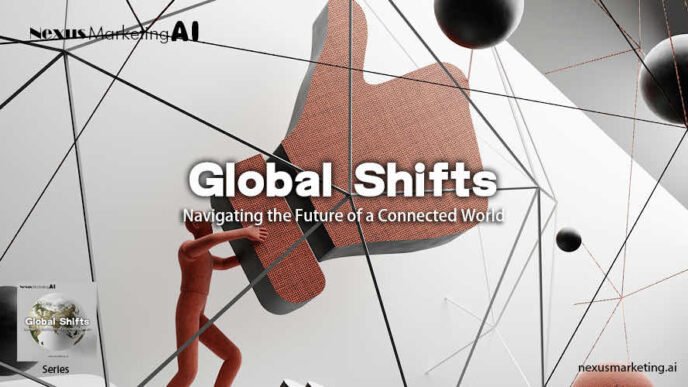Learn essential strategies and trends in content marketing to master this powerful tool for driving business success and audience engagement.
Table of Contents

Prefer to listen? Enjoy the audio version of this article
Curated audio version | Audio powered by AI
Why is content marketing so important in today’s digital landscape?

In today’s fast-paced digital landscape, content marketing is no longer just a buzzword—it’s become a vital part of any successful brand strategy. As consumers grow more skeptical of traditional advertising, brands need to find new ways to connect with their audience. This is where content marketing comes in, offering valuable, relevant, and engaging content that resonates on a deeper level.
Why is content marketing a must for brands today?
In a world overloaded with information, standing out has never been more challenging. The brands that succeed are the ones that truly understand their customers’ evolving needs and expectations. Today’s consumers crave authenticity, meaningful experiences, and content that adds real value to their lives. They’re no longer passive recipients of messages—they’re actively seeking out content that educates, entertains, and inspires.
How is technology driving innovation in content marketing?
Rapid advancements in technology have completely transformed how content is created, distributed, and consumed. From AI-driven content generation to data-powered strategies, the opportunities for innovation are endless. Brands that effectively use these tools are able to create personalized, impactful content that cuts through the noise and captures their audience’s attention.
Content Marketing Strategy: Your Growth Catalyst

When it comes to driving growth, a well-executed content marketing strategy can be the game-changer for your brand. Here’s how content marketing pushes the needle forward:

- Building Brand Awareness: Consistently delivering high-quality content helps establish your brand as a thought leader in your industry, making you the go-to source for information, solutions, and insights. As your content reaches more people, your brand’s recognition naturally grows.

- Driving Traffic: Great content attracts visitors to your website, whether through organic search, social media, or other channels. SEO-optimized content increases visibility, making it easier for potential customers to find you when they need your products or services.

- Generating Leads: Content that educates, informs, or solves problems for your audience can entice them to exchange their contact information for more valuable resources, like eBooks, webinars, or newsletters. This turns casual visitors into potential leads.

- Nurturing Relationships: Regularly engaging with your audience through content helps build long-term relationships. When your content consistently provides value, customers are more likely to trust your brand and come back for more, ultimately driving customer loyalty.

- Increasing Conversions: Strategic content marketing aligns with the buyer’s journey, guiding them from awareness to decision-making. Content that answers key questions or addresses pain points can directly influence purchasing decisions, leading to higher conversion rates.

- Supporting Sales: Content also plays a crucial role in supporting your sales team. Informative, targeted content can help your team close deals by providing prospects with the information they need to make informed decisions.

- Boosting SEO: High-quality content naturally attracts backlinks, shares, and engagement, all of which contribute to better search engine rankings. This helps drive more organic traffic to your site, fueling long-term growth.

- Enhancing Customer Experience: Content can help you personalize your communication with customers, tailoring messages to meet their specific needs and preferences. This enhances the overall customer experience, making it more likely they will remain loyal to your brand.
These points illustrate how a strategic content marketing approach can serve as a powerful engine for your brand’s growth, building relationships, driving traffic, and ultimately increasing sales.
Of course, a successful content marketing strategy is not just about crafting an excellent plan; it’s also about deeply understanding your audience, particularly as consumer behaviors and preferences continue to evolve. With Gen Z becoming a dominant force in the market, brands must continually adapt to meet their needs and expectations. Gen Z’s shopping behaviors, brand trust, and content preferences have already significantly shaped current content marketing trends. Let’s dive into how Gen Z is influencing brand-consumer relationships and redefining engagement through content.
Numbers That Matter: How Gen Z is Redefining Brand Trust and Shopping Trends

Here’s a breakdown of some key stats that highlight how Gen Z is influencing the world of content marketing and brand innovation:

“80% of Gen Z prefer personalized content.”
1. Brand Trust and Gen Z: According to Edelman’s 2024 Trust Barometer, 84% of global consumers state that sharing values with a brand is essential for their loyalty. For Gen Z, this is even more critical—nearly 60% of them feel a strong connection with people who use the same brands as they do .

“Social Media Shopping Trends: Gen Z Leads the Way.”
2. Gen Z’s Social Shopping Behavior: McKinsey research reveals that Gen Z is revolutionizing shopping habits. They purchase through social media platforms four times more often than older consumers. In the U.S., social commerce is expected to nearly double from $67 billion in 2024 to $145 billion by 2027 .

“Only Simple and Direct Content Captures Gen Z’s Attention.”
3. Brand Innovation and Consumer Perception: Hootsuite reports that 92% of Gen Z multitask while browsing the internet, emphasizing the need for brands to create simple, direct content that grabs attention quickly. Additionally, 87% of consumers, across all generations, prefer a personalized shopping experience, reinforcing the importance of tailored content marketing .
These insights underscore why brands need to innovate continuously and stay closely connected with consumers—especially with Gen Z, who are reshaping the rules of engagement.
The Many Faces of Content Marketing: How Each Type Shapes Your Strategy

Content marketing comes in many forms, and each plays a unique role in shaping your overall strategy. From educational articles to interactive webinars, here’s a breakdown of some key content marketing types and how they influence your brand’s success.

1. Blog Posts
- Overview: Blogs are a staple in content marketing. They’re versatile, SEO-friendly, and allow brands to consistently share insights, news, and educational content.
- Impact on Strategy: Regular blog posts can position your brand as an industry thought leader while driving organic traffic through targeted keywords. They are essential for building long-term relationships with your audience by providing ongoing value.

2. Web Pages
- Overview: Your website’s content is more than just product descriptions—it’s your brand’s digital storefront. Web pages include everything from your homepage to detailed service pages, designed to inform and convert visitors.
- Impact on Strategy: Optimizing web pages for SEO helps your brand rank higher on search engines, ensuring you’re discoverable. Well-crafted pages also guide visitors through the buyer’s journey, from awareness to conversion.

3. Ebooks and White Papers
- Overview: These long-form content types are in-depth resources that cover complex topics in a detailed manner. While ebooks are often more general and educational, white papers tend to be more technical and research-based.
- Impact on Strategy: Offering ebooks and white papers can attract high-quality leads, especially in B2B marketing. They serve as excellent lead magnets in exchange for contact information, helping to build your email list.

4. Webinars
- Overview: Webinars allow you to connect with your audience in real-time, providing a platform for live demonstrations, discussions, and Q&A sessions.
- Impact on Strategy: Webinars are powerful tools for generating leads, building authority, and engaging your audience. They can also be repurposed as on-demand content, adding long-term value to your content library.

5. Email Newsletters
- Overview: Email newsletters are a direct line to your audience, allowing you to share updates, exclusive content, and promotions straight to their inbox.
- Impact on Strategy: Newsletters keep your audience engaged, driving traffic back to your website and reinforcing your brand message. Personalized and targeted emails can significantly boost customer retention and conversions.

6. Case Studies
- Overview: Case studies tell the story of how your product or service solved a specific problem for a client. They provide real-world examples of your brand’s effectiveness.
- Impact on Strategy: Case studies build credibility and trust, particularly in B2B markets. They offer tangible proof of your value proposition, making them persuasive content for potential clients.

7. Social Media Posts
- Overview: Social media is a crucial channel for distributing your content and engaging with your audience. Posts can range from quick updates to longer threads that tell a story.
- Impact on Strategy: Social media amplifies your content’s reach, making it easier to engage with both current and potential customers. Platforms like LinkedIn and Twitter are particularly effective for B2B marketing, while Instagram and Facebook are better for B2C.
These diverse content types contribute to a well-rounded content marketing strategy, each playing a role in reaching and
Why Gen Z Isn’t Just About Short Clips: The Surprising Popularity of Long-Form Content

While short-form videos like TikToks and Instagram Reels are immensely popular, Gen Z is also deeply engaged with long-form video content across various platforms. Here’s how this shift impacts content marketing strategies:

“70% of Gen Z Watch Full-Length TV Weekly.”
1. Long-Form TV Shows and Streaming: Around 70% of Gen Z watches full-length TV content on a weekly basis, nearly matching the 80% who consume short-form videos just as frequently. This challenges the stereotype that Gen Z has a short attention span and prefers only quick content. Instead, they are finding value in immersive storytelling offered by TV shows, movies, and even detailed video essays .
Horowitzresearch

“60% of Gen Z Watch Long-Form TV on Traditional Screens.”
2. Diverse Consumption Across Devices: While Gen Z consumes a lot of content on their smartphones, a significant number are also watching long-form TV shows on larger screens, such as traditional TVs. In fact, 60% of Gen Zers report watching TV shows on their TV sets, yet they also engage with long-form content on mobile devices when convenience calls for it .
Noblehousemedia

“Fan Culture and Video Essays Thrive Among Gen Z.”
3. Fan Culture and Video Essays: One of the intriguing trends is the rise of fan culture content and video essays. Many Gen Z viewers dive deep into their favorite topics through hours-long analyses, proving that they are willing to invest time in detailed, in-depth content when it aligns with their passions. This trend is further bolstered by platforms like YouTube, where long-form fan-driven content and video essays are thriving .
Thinkwithgoogle

“Gen Z Use an Average of 6 Streaming Services.”
4. Streaming Services and Content Preferences: Gen Z uses an average of 6.1 streaming services, with platforms like Netflix, Disney+, and even free ad-supported services like Tubi and Pluto TV seeing a rise in popularity. This generation shows a strong preference for diverse genres, including movies, dramas, and animated series .
Newscaststudio
Takeaway for Marketers:
To capture Gen Z’s attention, brands should not only focus on short-form content but also consider the potential of long-form videos. From comprehensive tutorials to deep-dive video essays, there is a growing appetite among this audience for content that offers more depth and engagement. Crafting a balanced strategy that includes both quick, snackable content and longer, immersive experiences can help brands build stronger connections with this diverse and discerning generation.
What Makes Content Marketing Truly Exceptional? Unpacking the Secrets of Success

To craft a successful content marketing strategy, several core elements must come together to create content that resonates with audiences and drives results. Let’s break down what truly makes content marketing exceptional:

1. Originality
- Why It Matters: Original content sets your brand apart from competitors and establishes authority in your niche. Unique insights, research, and creative approaches ensure your audience sees value in your content, making it more likely to engage and share.
- Pro Tip: Always aim to provide new perspectives or angles that your competitors might not have covered, leveraging subject matter experts to add depth and credibility .

2. Value-Driven Content
- Why It Matters: Audiences are drawn to content that offers clear, tangible benefits—whether that’s educating them on a topic, solving a problem, or providing entertainment. Value-driven content positions your brand as a go-to resource, increasing customer trust and loyalty.
- Pro Tip: Focus on creating content that addresses your audience’s pain points. Detailed research and actionable advice will keep them coming back for more .

3. Audience-Centered Approach
- Why It Matters: Understanding your audience is key to crafting content that resonates. This means knowing their preferences, challenges, and where they are in their customer journey. Tailoring your content to these specifics makes it more impactful and relevant.
- Pro Tip: Develop detailed audience personas and use data-driven insights to personalize content. Tools like AI can help analyze behavior and preferences to optimize content .

4. High-Quality and Engaging Formats
- Why It Matters: High-quality content that is well-researched, visually appealing, and easy to digest keeps audiences engaged. Using a variety of content formats—such as blog posts, infographics, and interactive content—ensures that your content reaches and engages different audience segments.
- Pro Tip: Mix up your content formats to cater to various audience preferences. Engaging formats like quizzes, infographics, and interactive content are particularly effective in keeping users hooked .

5. Consistency and Planning
- Why It Matters: Consistency in your content output helps maintain audience engagement and strengthens your brand’s presence. A well-structured content calendar ensures you’re consistently delivering quality content aligned with your strategy.
- Pro Tip: Use tools like Trello, Asana, or Google Calendar to create a detailed content calendar that outlines topics, deadlines, and publishing schedules .

6. Data-Driven Insights
- Why It Matters: Using data to inform your content strategy allows for continuous optimization. Analyzing engagement metrics, conversion rates, and audience behavior helps refine content and ensure it aligns with evolving audience preferences.
- Pro Tip: Incorporate analytics tools like Google Analytics and SEMrush to track performance and make data-backed decisions that enhance your content strategy .
By combining these elements—originality, value, audience focus, engaging formats, consistency, and data-driven insights—you can create content that not only captivates your audience but also drives real busines
Mastering the Funnel: How to Create Content for Every Stage of the Customer Journey

Creating effective content for different stages of the marketing funnel is key to nurturing prospects and turning them into loyal customers. The funnel can be broadly divided into three main stages—Top of the Funnel (TOFU), Middle of the Funnel (MOFU), and Bottom of the Funnel (BOFU). Each stage requires different content strategies to address the unique needs and behaviors of your audience.
Here’s a breakdown of how to create content for each stage:

1. Top of the Funnel (TOFU): Awareness Stage
- Purpose: Attract and educate. This is where potential customers first become aware of your brand and the problems you can solve.
- Content Types: Blog posts, infographics, social media posts, podcasts, and educational ebooks or guides.
- Key Strategy: Focus on providing value without selling. Your goal is to inform and help, not push a product. For example, blog posts on relevant industry topics can attract visitors by offering solutions to their problems .
- Example: Ramit Sethi’s blog, which explains passive income without directly promoting his courses, serves as an excellent TOFU content model .

2. Middle of the Funnel (MOFU): Consideration Stage
- Purpose: Engage and nurture. Here, prospects are already aware of their problem and are now evaluating potential solutions, including yours.
- Content Types: Case studies, webinars, product comparisons, buying guides, and detailed FAQs.
- Key Strategy: Show expertise and build trust. This stage is about convincing prospects that your solution is the right one for them. You should highlight the benefits of your products/services and overcome any objections they might have .
- Example: A case study showcasing how a product solved a specific problem for a client can effectively persuade potential customers that your solution works .

3. Bottom of the Funnel (BOFU): Decision Stage
- Purpose: Convert. By this point, your prospects are ready to make a purchasing decision. Your content should push them towards choosing your brand.
- Content Types: Product pages, customer reviews, success stories, and personalized offers.
- Key Strategy: Focus on conversion. Use social proof, urgency (like limited-time offers), and clear calls to action to encourage purchases .
- Example: Serta’s product pages, which showcase detailed information, customer reviews, and urgency-inducing tactics, are great examples of BOFU content designed to convert .
Data-Driven Insights
- TOFU Content Impact: Studies show that TOFU content like blog posts can drive significant organic traffic and build brand awareness, with the goal of attracting as many leads as possible. Businesses using educational content in the awareness stage see higher engagement rates and brand recall .
- MOFU Content Effectiveness: At the consideration stage, metrics like conversion rates, lead generation, and time on page are crucial for evaluating success. Brands that use webinars and case studies effectively in the MOFU stage report better lead nurturing and qualification .
- BOFU Content Power: The final decision stage is all about ROI. Businesses that effectively leverage customer testimonials and detailed product information at this stage often experience higher conversion rates .
By tailoring your content to the different stages of the funnel, you ensure that you’re meeting your audience’s needs at every step of their journey, ultimately driving better results for your marketing efforts.
Reinforcing Core Principles of Content Marketing

In the shifting digital landscape, content remains at the heart of brand communication. However, it’s not just about producing content—it’s about strategically aligning that content with your audience’s journey and the ever-evolving technological landscape. By deeply understanding your audience and leveraging personalization, your brand can effectively build trust, drive engagement, and nurture lasting relationships.
Incorporating a blend of content types—from blog posts and case studies to in-depth video content—can empower brands to maintain relevance and foster growth. The ability to adapt to emerging trends, like the surge in video consumption and the increasing demand for tailored experiences, will continue to shape content strategies moving forward.
A focus on delivering timely, relevant content ensures your brand doesn’t just compete but stands out, providing lasting value to your audience.
FAQs
-
How does content marketing contribute to long-term brand growth?
Content marketing contributes to long-term brand growth by building brand awareness, driving consistent traffic, generating leads, nurturing relationships, and boosting conversions. It allows brands to establish authority and trust with their audience by delivering valuable and relevant content consistently.
-
What are the most effective content types for different stages of the marketing funnel?
Each stage of the funnel requires different content types. At the top of the funnel (TOFU), focus on educational content like blog posts, infographics, and social media content. In the middle of the funnel (MOFU), use webinars, case studies, and buying guides to nurture leads. At the bottom of the funnel (BOFU), customer reviews, product pages, and success stories help convert prospects into customers.
-
How does Gen Z’s preference for long-form content impact content marketing strategies?
Despite their love for short clips, Gen Z also engages with long-form content, such as TV shows and detailed video essays. This trend impacts content marketing strategies by pushing brands to create a balance between quick, snackable content and in-depth, immersive experiences that cater to this generation’s diverse content consumption habits.
-
What role does personalization play in content marketing success?
Personalization is critical in content marketing success as it helps brands deliver tailored content that resonates with individual preferences and behaviors. Personalized content enhances user experience, builds trust, and increases the likelihood of conversions, making it a powerful tool in today’s digital marketing landscape.
-
Why is consistency important in content marketing, and how can it be maintained?
Consistency in content marketing is crucial because it helps maintain audience engagement and strengthens brand recognition. Brands can ensure consistency by using editorial calendars, content management tools like Trello or Asana, and maintaining a steady flow of high-quality content that aligns with their overall strategy.
-
How can data-driven insights optimize content marketing efforts?
Data-driven insights allow brands to continuously refine their content strategy by analyzing metrics such as engagement, conversion rates, and audience behavior. Tools like Google Analytics and SEMrush help brands track performance, optimize content for better results, and ensure their content aligns with audience preferences.












